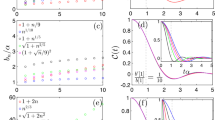Abstract
Mathematical models of cell electrical activity typically consist of a current balance equation, channel activation (or inactivation) variables and concentrations of regulatory agents. These models can be thought of as nonlinear filters whose input is some applied current I (possibly zero) and output is a membrane potential V. A natural question to ask is if the applied current I can be deduced from the potential V. For a surprisingly large class of models the answer to this question is yes. To show this, we first demonstrate how many models can be embedded into higher dimensional quasilinear systems. For quasilinear models, a procedure for determining the inverse of the nonlinear filter is then described and demonstrated on two models: (1) the FitzHugh-Nagumo model and (2) the Sherman-Rinzel-Keizer (SRK) [Sherman et al., (1988, Biophysics Journal, 54, 411–425)] model of bursting electrical activity in pancreatic β-cells. For the latter example, the inverse problem is then used to deduce model parameter values for which the model and experimental data agree in some measure. An advantage of the correlation technique is that experimental values for activation (and/or regulatory) variables need not be known to make the estimates for these parameter values.
Similar content being viewed by others
References
Casti, J. L. (1985). Nonlinear System Theory, Orlando, FL: Academic Press.
FitzHugh, R. (1961). Impulses and physiological states in theoretical models of nerve membranes. Biophys. J. 1, 445–466.
Himmelblau, D. M. (1972). Applied Nonlinear Programming, New York, NY: McGraw-Hill Book Company.
Hodgkin, A. L. and A. F. Huxley (1952). A quantitative description of membrane current and its application to conduction and excitation in nerve. J. Physiol. (Lond.) 117, 500–544.
Nagumo, J. S., S. Arimoto and S. Yoshizawa (1962). An action pulse transmission line simulating nerve axon, Proceedings of the IRE, 50, pp. 2061–2071.
Nelder, J. and R. Mead (1965). A simplex method for function minimization. Comput. J. 7, 308–313.
Pernarowski, M., R. M. Miura and J. Kevorkian (1991). The Sherman-Rinzel-Keizer model for bursting electrical activity in the pancreatic β-cell, in Differential Equation Models in Population Dynamics and Physiology, Lecture Notes in Biomathematics 92, S. Busenberg and M. Martelli (Eds), Berlin: Springer-Verlag, pp. 34–53.
Sherman, A., J. Rinzel and J. Keizer (1988). Emergence of organized bursting in clusters of pancreatic β-cells by channel sharing. Biophys. J. 54, 411–425.
Author information
Authors and Affiliations
Additional information
This work was supported by the National Science Foundation grant DMS-97-04-966.
Rights and permissions
About this article
Cite this article
Pernarowski, M. Controllability of excitable systems. Bull. Math. Biol. 63, 167–184 (2001). https://doi.org/10.1006/bulm.2000.0212
Received:
Accepted:
Issue Date:
DOI: https://doi.org/10.1006/bulm.2000.0212




